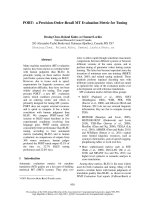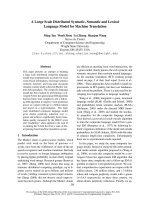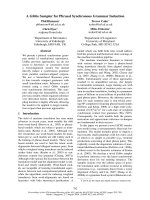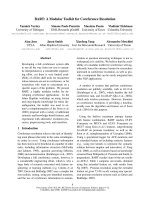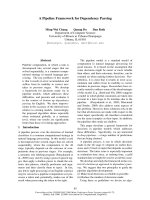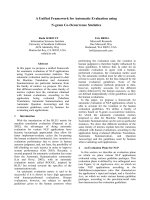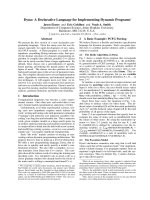Báo cáo khoa học: "A Graphical Interface for MT Evaluation and Error Analysis" doc
Bạn đang xem bản rút gọn của tài liệu. Xem và tải ngay bản đầy đủ của tài liệu tại đây (331.5 KB, 6 trang )
Proceedings of the 50th Annual Meeting of the Association for Computational Linguistics, pages 139–144,
Jeju, Republic of Korea, 8-14 July 2012.
c
2012 Association for Computational Linguistics
A Graphical Interface for MT Evaluation and Error Analysis
Meritxell Gonz
`
alez and Jes
´
us Gim
´
enez and Llu
´
ıs M
`
arquez
TALP Research Center
Universitat Polit
`
ecnica de Catalunya
{mgonzalez,jgimenez,lluism}@lsi.upc.edu
Abstract
Error analysis in machine translation is a nec-
essary step in order to investigate the strengths
and weaknesses of the MT systems under de-
velopment and allow fair comparisons among
them. This work presents an application that
shows how a set of heterogeneous automatic
metrics can be used to evaluate a test bed of
automatic translations. To do so, we have
set up an online graphical interface for the
ASIYA toolkit, a rich repository of evaluation
measures working at different linguistic lev-
els. The current implementation of the inter-
face shows constituency and dependency trees
as well as shallow syntactic and semantic an-
notations, and word alignments. The intelli-
gent visualization of the linguistic structures
used by the metrics, as well as a set of navi-
gational functionalities, may lead towards ad-
vanced methods for automatic error analysis.
1 Introduction
Evaluation methods are a key ingredient in the de-
velopment cycle of machine translation (MT) sys-
tems. As illustrated in Figure 1, they are used to
identify and analyze the system weak points (error
analysis), to introduce new improvements and adjust
the internal system parameters (system refinement),
and to measure the system performance in compari-
son to other systems or previous versions of the same
system (evaluation).
We focus here on the processes involved in the
error analysis stage in which MT developers need to
understand the output of their systems and to assess
the improvements introduced.
Automatic detection and classification of the er-
rors produced by MT systems is a challenging prob-
lem. The cause of such errors may depend not only
on the translation paradigm adopted, but also on the
language pairs, the availability of enough linguistic
resources and the performance of the linguistic pro-
cessors, among others. Several past research works
studied and defined fine-grained typologies of trans-
lation errors according to various criteria (Vilar et
al., 2006; Popovi
´
c et al., 2006; Kirchhoff et al.,
2007), which helped manual annotation and human
analysis of the systems during the MT development
cycle. Recently, the task has received increasing at-
tention towards the automatic detection, classifica-
tion and analysis of these errors, and new tools have
been made available to the community. Examples
of such tools are AMEANA (Kholy and Habash,
2011), which focuses on morphologically rich lan-
guages, and Hjerson (Popovi
´
c, 2011), which ad-
dresses automatic error classification at lexical level.
In this work we present an online graphical inter-
face to access ASIYA, an existing software designed
to evaluate automatic translations using an heteroge-
neous set of metrics and meta-metrics. The primary
goal of the online interface is to allow MT develop-
ers to upload their test beds, obtain a large set of met-
ric scores and then, detect and analyze the errors of
their systems using just their Internet browsers. Ad-
ditionally, the graphical interface of the toolkit may
help developers to better understand the strengths
and weaknesses of the existing evaluation measures
and to support the development of further improve-
ments or even totally new evaluation metrics. This
information can be gathered both from the experi-
139
Figure 1: MT systems development cycle
ence of ASIYA’s developers and also from the statis-
tics given through the interface to the ASIYA’s users.
In the following, Section 2 gives a general
overview of the ASIYA toolkit. Section 3 describes
the variety of information gathered during the eval-
uation process, and Section 4 provides details on the
graphical interface developed to display this infor-
mation. Finally, Section 5 overviews recent work re-
lated to MT error analysis, and Section 6 concludes
and reports some ongoing and future work.
2 The ASIYA Toolkit
ASIYA is an open toolkit designed to assist devel-
opers of both MT systems and evaluation measures
by offering a rich set of metrics and meta-metrics
for assessing MT quality (Gim
´
enez and M
`
arquez,
2010a). Although automatic MT evaluation is still
far from manual evaluation, it is indeed necessary
to avoid the bottleneck introduced by a fully man-
ual evaluation in the system development cycle. Re-
cently, there has been empirical and theoretical justi-
fication that a combination of several metrics scoring
different aspects of translation quality should corre-
late better with humans than just a single automatic
metric (Amig
´
o et al., 2011; Gim
´
enez and M
`
arquez,
2010b).
ASIYA offers more than 500 metric variants for
MT evaluation, including the latest versions of the
most popular measures. These metrics rely on dif-
ferent similarity principles (such as precision, recall
and overlap) and operate at different linguistic layers
(from lexical to syntactic and semantic). A general
classification based on the similarity type is given
below along with a brief summary of the informa-
tion they use and the names of a few examples
1
.
Lexical similarity: n-gram similarity and edit dis-
tance based on word forms (e.g., PER, TER,
WER, BLEU, NIST, GTM, METEOR).
Syntactic similarity: based on part-of-speech tags,
base phrase chunks, and dependency and con-
stituency trees (e.g., SP-Overlap-POS, SP-
Overlap-Chunk, DP-HWCM, CP-STM).
Semantic similarity: based on named entities, se-
mantic roles and discourse representation (e.g.,
NE-Overlap, SR-Overlap, DRS-Overlap).
Such heterogeneous set of metrics allow the user
to analyze diverse aspects of translation quality at
system, document and sentence levels. As discussed
in (Gim
´
enez and M
`
arquez, 2008), the widely used
lexical-based measures should be considered care-
fully at sentence level, as they tend to penalize trans-
lations using different lexical selection. The combi-
nation with complex metrics, more focused on ad-
equacy aspects of the translation (e.g., taking into
account also semantic information), should help re-
ducing this problem.
3 The Metric-dependent Information
ASIYA operates over a fixed set of translation test
cases, i.e., a source text, a set of candidate trans-
lations and a set of manually produced reference
translations. To run ASIYA the user must provide
a test case and select the preferred set of metrics
(it may depend on the evaluation purpose). Then,
ASIYA outputs complete tables of score values for
all the possible combination of metrics, systems,
documents and segments. This kind of results is
valuable for rapid evaluation and ranking of trans-
lations and systems. However, it is unfriendly for
MT developers that need to manually analyze and
compare specific aspects of their systems.
During the evaluation process, ASIYA generates
a number of intermediate analysis containing par-
tial work outs of the evaluation measures. These
data constitute a priceless source for analysis pur-
poses since a close examination of their content al-
lows for analyzing the particular characteristics that
1
A more detailed description of the metric set and its imple-
mentation can be found in (Gim
´
enez and M
`
arquez, 2010b).
140
Reference The remote control of the Wii
helps to diagnose an infantile
ocular disease .
O
l
score
Candidate 1 The Wii Remote to help diag-
nose childhood eye disease .
7
17
= 0.41
Candidate 2 The control of the Wii helps
to diagnose an ocular infantile
disease .
13
14
= 0.93
Table 1: The reference sentence, two candidate
translation examples and the O
l
scores calculation
differentiate the score values obtained by each can-
didate translation.
Next, we review the type of information used by
each family of measures according to their classifi-
cation, and how this information can be used for MT
error analysis purposes.
Lexical information. There are several variants un-
der this family. For instance, lexical overlap (O
l
)
is an F-measure based metric, which computes sim-
ilarity roughly using the Jaccard coefficient. First,
the sets of all lexical items that are found in the ref-
erence and the candidate sentences are considered.
Then, O
l
is computed as the cardinality of their in-
tersection divided by the cardinality of their union.
The example in Table 1 shows the counts used to cal-
culate O
l
between the reference and two candidate
translations (boldface and underline indicate non-
matched items in candidate 1 and 2, respectively).
Similarly, metrics in another category measure the
edit distance of a translation, i.e., the number of
word insertions, deletions and substitutions that are
needed to convert a candidate translation into a ref-
erence. From the algorithms used to calculate these
metrics, these words can be identified in the set of
sentences and marked for further processing. On
another front, metrics as BLEU or NIST compute
a weighted average of matching n-grams. An inter-
esting information that can be obtained from these
metrics are the weights assigned to each individual
matching n-gram. Variations of all of these mea-
sures include looking at stems, synonyms and para-
phrases, instead of the actual words in the sentences.
This information can be obtained from the imple-
mentation of the metrics and presented to the user
through the graphical interface.
Syntactic information. ASIYA considers three lev-
els of syntactic information: shallow, constituent
and dependency parsing. The shallow parsing an-
notations, that are obtained from the linguistic pro-
cessors, consist of word level part-of-speech, lem-
mas and chunk Begin-Inside-Outside labels. Use-
ful figures such as the matching rate of a given
(sub)category of items are the base of a group of
metrics (i.e., the ratio of prepositions between a
reference and a candidate). In addition, depen-
dency and constituency parse trees allow for captur-
ing other aspects of the translations. For instance,
DP-HCWM is a specific subset of the dependency
measures that consists of retrieving and matching all
the head-word chains (or the ones of a given length)
from the dependency trees. Similarly, CP-STM, a
subset of the constituency parsing family of mea-
sures, consists of computing the lexical overlap ac-
cording to the phrase constituent of a given type.
Then, for error analysis purposes, parse trees com-
bine the grammatical relations and the grammati-
cal categories of the words in the sentence and dis-
play the information they contain. Figure 2 and 3
show, respectively, several annotation levels of the
sentences in the example and the constituency trees.
Semantic information. ASIYA distinguishes also
three levels of semantic information: named enti-
ties, semantic roles and discourse representations.
The former are post-processed similarly to the lex-
ical annotations discussed above; and the semantic
predicate-argument trees are post-processed and dis-
played in a similar manner to the syntactic trees.
Instead, the purpose of the discourse representation
analysis is to evaluate candidate translations at doc-
ument level. In the nested discourse structures we
could identify the lexical choices for each discourse
sub-type. Presenting this information to the user re-
mains as an important part of the future work.
4 The Graphical Interface
This section presents the web application that makes
possible a graphical visualization and interactive ac-
cess to ASIYA. The purpose of the interface is
twofold. First, it has been designed to facilitate the
use of the ASIYA toolkit for rapid evaluation of test
beds. And second, we aim at aiding the analysis of
the errors produced by the MT systems by creating
141
Figure 2: PoS, chunk and named entity annota-
tions on the source, reference and two translation
hypotheses
Figure 3: Constituency trees for the reference and
second translation candidate
a significant visualization of the information related
to the evaluation metrics.
The online interface consists of a simple web form
to supply the data required to run ASIYA, and then,
it offers several views that display the results in
friendly and flexible ways such as interactive score
tables, graphical parsing trees in SVG format and
interactive sentences holding the linguistic annota-
tions captured during the computation of the met-
rics, as described in Section 3.
4.1 Online MT evaluation
ASIYA allows to compute scores at three granular-
ity levels: system (entire test corpus), document and
sentence (or segment). The online application ob-
tains the measures for all the metrics and levels and
generates an interactive table of scores displaying
the values for all the measures. Table organiza-
Figure 4: The bar charts plot to compare the metric
scores for several systems
tion can swap among the three levels of granularity,
and it can also be transposed with respect to sys-
tem and metric information (transposing rows and
columns). When the metric basis table is shown, the
user can select one or more metric columns in or-
der to re-rank the rows accordingly. Moreover, the
source, reference and candidate translation are dis-
played along with metric scores. The combination of
all these functionalities makes it easy to know which
are the highest/lowest-scored sentences in a test set.
We have also integrated a graphical library
2
to
generate real-time interactive plots to show the met-
ric scores graphically. The current version of the in-
terface shows interactive bar charts, where different
metrics and systems can be combined in the same
plot. An example is shown in Figure 4.
4.2 Graphically-aided Error Analysis and
Diagnosis
Human analysis is crucial in the development cy-
cle because humans have the capability to spot er-
rors and analyze them subjectively, in relation to the
underlying system that is being examined and the
scores obtained. Our purpose, as mentioned previ-
ously, is to generate a graphical representation of
the information related to the source and the trans-
lations, enabling a visual analysis of the errors. We
have focused on the linguistic measures at the syn-
tactic and semantic level, since they are more robust
than lexical metrics when comparing systems based
on different paradigms. On the one hand, one of
the views of the interface allows a user to navigate
and inspect the segments of the test set. This view
highlights the elements in the sentences that match a
2
/>142
given criteria based on the various linguistic annota-
tions aforementioned (e.g., PoS prepositions). The
interface integrates also the mechanisms to upload
word-by-word alignments between the source and
any of the candidates. The alignments are also vi-
sualized along with the rest of the annotations, and
they can be also used to calculate artificial annota-
tions projected from the source in such test beds for
which there is no linguistic processors available. On
the other hand, the web application includes a library
for SVG graph generation in order to create the de-
pendency and the constituent trees dynamically (as
shown in Figure 3).
4.3 Accessing the Demo
The online interface is fully functional and accessi-
ble at Al-
though the ASIYA toolkit is not difficult to install,
some specific technical skills are still needed in or-
der to set up all its capabilities (i.e., external com-
ponents and resources such as linguistic processors
and dictionaries). Instead, the online application re-
quires only an up to date browser. The website in-
cludes a tarball with sample input data and a video
recording, which demonstrates the main functional-
ities of the interface and how to use it.
The current web-based interface allows the user
to upload up to five candidate translation files, five
reference files and one source file (maximum size of
200K each, which is enough for test bed of about
1K sentences). Alternatively, the command based
version of ASIYA can be used to intensively evaluate
a large set of data.
5 Related Work
In the literature, we can find detailed typologies of
the errors produced by MT systems (Vilar et al.,
2006; Farr
´
us et al., 2011; Kirchhoff et al., 2007) and
graphical interfaces for human classification and an-
notation of these errors, such as BLAST (Stymne,
2011). They represent a framework to study the
performance of MT systems and develop further re-
finements. However, they are defined for a specific
pair of languages or domain and they are difficult
to generalize. For instance, the study described in
(Kirchhoff et al., 2007) focus on measures relying on
the characterization of the input documents (source,
genre, style, dialect). In contrast, Farr
´
us et al. (2011)
classify the errors that arise during Spanish-Catalan
translation at several levels: orthographic, morpho-
logical, lexical, semantic and syntactic errors.
Works towards the automatic identification and
classification of errors have been conducted very re-
cently. Examples of these are (Fishel et al., 2011),
which focus on the detection and classification of
common lexical errors and misplaced words using
a specialized alignment algorithm; and (Popovi
´
c
and Ney, 2011), which addresses the classifica-
tion of inflectional errors, word reordering, missing
words, extra words and incorrect lexical choices us-
ing a combination of WER, PER, RPER and HPER
scores. The AMEANA tool (Kholy and Habash,
2011) uses alignments to produce detailed morpho-
logical error diagnosis and generates statistics at dif-
ferent linguistic levels. To the best of our knowl-
edge, the existing approaches to automatic error
classification are centered on the lexical, morpho-
logical and shallow syntactic aspects of the transla-
tion, i.e., word deletion, insertion and substitution,
wrong inflections, wrong lexical choice and part-
of-speech. In contrast, we introduce additional lin-
guistic information, such as dependency and con-
stituent parsing trees, discourse structures and se-
mantic roles. Also, there exist very few tools de-
voted to visualize the errors produced by the MT
systems. Here, instead of dealing with the automatic
classification of errors, we deal with the automatic
selection and visualization of the information used
by the evaluation measures.
6 Conclusions and Future Work
The main goal of the ASIYA toolkit is to cover the
evaluation needs of researchers during the develop-
ment cycle of their systems. ASIYA generates a
number of linguistic analyses over both the candi-
date and the reference translations. However, the
current command-line interface returns the results
only in text mode and does not allow for fully ex-
ploiting this linguistic information. We present a
graphical interface showing a visual representation
of such data for monitoring the MT development cy-
cle. We believe that it would be very helpful for car-
rying out tasks such as error analysis, system com-
parison and graphical representations.
143
The application described here is the first release
of a web interface to access ASIYA online. So
far, it includes the mechanisms to analyze 4 out of
10 categories of metrics: shallow parsing, depen-
dency parsing, constituent parsing and named en-
tities. Nonetheless, we aim at developing the sys-
tem until we cover all the metric categories currently
available in ASIYA.
Regarding the analysis of the sentences, we have
conducted a small experiment to show the ability of
the interface to use word level alignments between
the source and the target sentences. In the near fu-
ture, we will include the mechanisms to upload also
phrase level alignments. This functionality will also
give the chance to develop a new family of evalua-
tion metrics based on these alignments.
Regarding the interactive aspects of the interface,
the grammatical graphs are dynamically generated
in SVG format, which proffers a wide range of inter-
active functionalities. However their interactivity is
still limited. Further development towards improved
interaction would provide a more advanced manip-
ulation of the content, e.g., selection, expansion and
collapse of branches.
Concerning the usability of the interface, we will
add an alternative form for text input, which will re-
quire users to input the source, reference and candi-
date translation directly without formatting them in
files, saving a lot of effort when users need to ana-
lyze the translation results of one single sentence.
Finally, in order to improve error analysis capa-
bilities, we will endow the application with a search
engine able to filter the results according to varied
user defined criteria. The main goal is to provide
the mechanisms to select a case set where, for in-
stance, all the sentences are scored above (or below)
a threshold for a given metric (or a subset of them).
Acknowledgments
This research has been partially funded by the Span-
ish Ministry of Education and Science (OpenMT-
2, TIN2009-14675-C03) and the European Commu-
nity’s Seventh Framework Programme under grant
agreement numbers 247762 (FAUST project, FP7-
ICT-2009- 4-247762) and 247914 (MOLTO project,
FP7-ICT-2009-4- 247914).
References
Enrique Amig
´
o, Julio Gonzalo, Jes
´
us Gim
´
enez, and Fe-
lisa Verdejo. 2011. Corroborating text evaluation re-
sults with heterogeneous measures. In Proc. of the
EMNLP, Edinburgh, UK, pages 455–466.
Mireia Farr
´
us, Marta R. Costa-Juss
`
a, Jos
´
e B. Mari
˜
no,
Marc Poch, Adolfo Hern
´
andez, Carlos Henr
´
ıquez, and
Jos
´
e A. Fonollosa. 2011. Overcoming Statistical Ma-
chine Translation Limitations: Error Analysis and Pro-
posed Solutions for the Catalan—Spanish Language
Pair. LREC, 45(2):181–208.
Mark Fishel, Ond
ˇ
rej Bojar, Daniel Zeman, and Jan Berka.
2011. Automatic Translation Error Analysis. In Proc.
of the 14th TSD, volume LNAI 3658. Springer Verlag.
Jes
´
us Gim
´
enez and Llu
´
ıs M
`
arquez. 2008. Towards Het-
erogeneous Automatic MT Error Analysis. In Proc. of
LREC, Marrakech, Morocco.
Jes
´
us Gim
´
enez and Llu
´
ıs M
`
arquez. 2010a. Asiya:
An Open Toolkit for Automatic Machine Translation
(Meta-)Evaluation. The Prague Bulletin of Mathemat-
ical Linguistics, (94):77–86.
Jes
´
us Gim
´
enez and Llu
´
ıs M
`
arquez. 2010b. Linguistic
Measures for Automatic Machine Translation Evalua-
tion. Machine Translation, 24(3–4):77–86.
Ahmed El Kholy and Nizar Habash. 2011. Automatic
Error Analysis for Morphologically Rich Languages.
In Proc. of the MT Summit XIII, Xiamen, China, pages
225–232.
Katrin Kirchhoff, Owen Rambow, Nizar Habash, and
Mona Diab. 2007. Semi-Automatic Error Analysis for
Large-Scale Statistical Machine Translation Systems.
In Proc. of the MT Summit XI, Copenhagen, Denmark.
Maja Popovi
´
c and Hermann Ney. 2011. Towards Auto-
matic Error Analysis of Machine Translation Output.
Computational Linguistics, 37(4):657–688.
Maja Popovi
´
c, Hermann Ney, Adri
`
a de Gispert, Jos
´
e B.
Mari
˜
no, Deepa Gupta, Marcello Federico, Patrik Lam-
bert, and Rafael Banchs. 2006. Morpho-Syntactic
Information for Automatic Error Analysis of Statisti-
cal Machine Translation Output. In Proc. of the SMT
Workshop, pages 1–6, New York City, USA. ACL.
Maja Popovi
´
c. 2011. Hjerson: An Open Source Tool
for Automatic Error Classification of Machine Trans-
lation Output. The Prague Bulletin of Mathematical
Linguistics, 96:59–68.
Sara Stymne. 2011. Blast: a Tool for Error Analysis of
Machine Translation Output. In Proc. of the 49th ACL,
HLT, Systems Demonstrations, pages 56–61.
David Vilar, Jia Xu, Luis Fernando D’Haro, and Her-
mann Ney. 2006. Error Analysis of Machine Trans-
lation Output. In Proc. of the LREC, pages 697–702,
Genoa, Italy.
144


